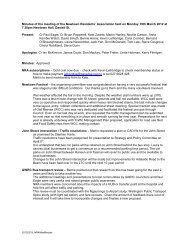Draft Town Belt Management Plan - Wellington City Council
Draft Town Belt Management Plan - Wellington City Council
Draft Town Belt Management Plan - Wellington City Council
Create successful ePaper yourself
Turn your PDF publications into a flip-book with our unique Google optimized e-Paper software.
The new balance – indigenous and exotic<br />
This changing perception of gorse, together with increased community appreciation of native<br />
vegetation, matched the emergence in the 1970s of environmentalism and ecological<br />
consciousness. Native vegetation was seen increasingly as a fast-disappearing resource and a<br />
symbol of New Zealand identity that should be conserved. By the 1980s, citizens were urging the<br />
<strong>Council</strong> not to clear gorse on the <strong>Town</strong> <strong>Belt</strong>, while at the same time recommending more native tree<br />
planting.<br />
The 1990s and 2000s saw ‘sustainability’ and ‘biodiversity’ become increasingly mainstream<br />
vocabulary in both public consciousness and central government/<strong>Council</strong> policy. In 1989, the<br />
<strong>Council</strong> launched ‘Campaign 2000’, a 10-year campaign towards achieving ‘a sustainable<br />
<strong>Wellington</strong> ecology’ that included plans for a major citywide tree planting programme. In 2000, the<br />
New Zealand Biodiversity Strategy was released and in 2007 the <strong>Council</strong> published its Biodiversity<br />
Action <strong>Plan</strong>, in which the restoration of native forest on areas of the <strong>Town</strong> <strong>Belt</strong> featured as part of<br />
the citywide strategy.<br />
As already mentioned, Parks Directors, McKenzie and Hutt, had advocated planting native species<br />
since the 1920s, although implementation had been ad hoc. When the first management policy<br />
document specific to the <strong>Town</strong> <strong>Belt</strong> was approved in 1975, a similar approach was adopted; to use<br />
native species wherever possible while continuing to use exotic species “for practical reasons”.<br />
The 1995 management plan took this a step further, specifying an overall objective of changing the<br />
vegetation balance from the existing 20 percent native cover to 60 percent over a 50 to 100-year<br />
period. The existing vegetation, including grassland and shrub land, had been surveyed and<br />
mapped in detail in the plan’s preparation and maps of the proposed new balance were included in<br />
the plan.<br />
<strong>Plan</strong>ting solely with native species was not advocated, however. Some replacement conifer planting<br />
was recommended for difficult sites or to perpetuate landmark features. The public had generally<br />
favoured increasing the proportion of native vegetation but wanted to see areas of mixed plantings<br />
and conifers retained for their amenity and heritage value. The <strong>Town</strong> <strong>Belt</strong>’s conifers – dark,<br />
forbidding and needing topping as some perceived them – were regarded by others as part of<br />
<strong>Wellington</strong>’s character and an important historic link back to the early plantings derived from the<br />
Botanic Garden. This latter attitude was reflected in periodic protests when conifers have been<br />
removed for safety reasons.<br />
During the 1990s and 2000s,<br />
the ageing condition of the<br />
conifer plantations became an<br />
issue as the risk of tree falls<br />
increased. A risk assessment<br />
was carried out and a plan<br />
adopted to progressively<br />
remove the most hazardous<br />
trees. Where access was<br />
difficult on steep slopes above<br />
vulnerable housing, helicopter<br />
extraction was the only option,<br />
despite the cost, and this<br />
attracted much public and<br />
media attention. The<br />
vulnerable state of the old<br />
plantations was graphically<br />
illustrated in 2004 when a<br />
storm brought down many of<br />
the ageing conifers, particularly<br />
on Te Ahumairangi Hill<br />
(Tinakori Hill).<br />
218<br />
Figure 12: Storm damage among the ageing conifers, Te<br />
Ahumairangi Hill (Tinakori Hill), 2005.<br />
(<strong>Wellington</strong> <strong>City</strong> <strong>Council</strong>)<br />
<strong>Draft</strong> <strong>Town</strong> <strong>Belt</strong> <strong>Management</strong> <strong>Plan</strong> October 2012





